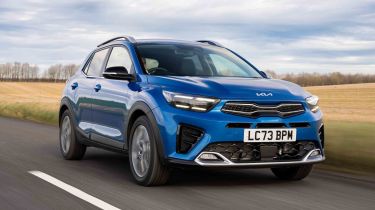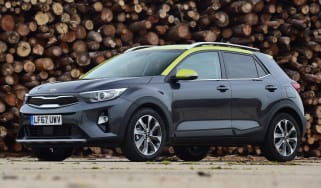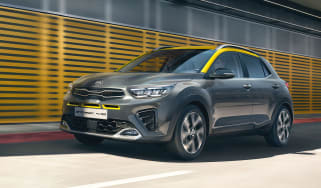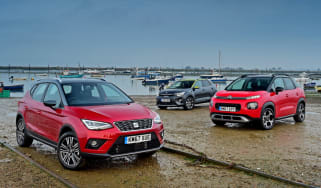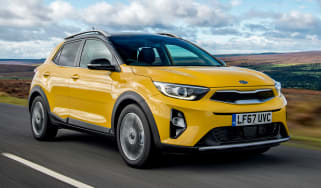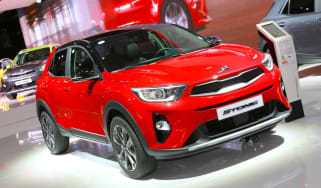Kia Stonic review
The Kia Stonic is a decent small crossover, but its rivals have it beaten for style, space and efficiency

Is the Kia Stonic a good car?
Outliving the car upon which it is based, the Kia Stonic has taken over from its Kia Rio sibling to offer a supermini-sized car, just in a more popular SUV bodystyle with slightly tougher looks and a raised ride height that buyers of such cars desire.
It drives reasonably well, is well-equipped, and is backed by a lengthy seven-year warranty that offers a level of reassurance that might seal the deal for some buyers. However, it has a fidgety low-speed ride, an interior that isn’t exactly plush or exciting to look at, and it isn’t the cheapest small SUV around. Overall, the Stonic does many things well, but it isn’t a particularly outstanding offering in a class of highly accomplished rivals.
Key specs | |
| Fuel type | Petrol |
| Body style | Small SUV |
| Powertrain | 1.0-litre 3cyl turbocharged petrol, front-wheel drive |
| Safety | 2017 rating expired |
| Warranty | Seven years/100,000 miles |
The Stonic range starts at a little over £21,000 for a manual petrol in 2 trim, and tops out at just under £26,000 for a GT-Line S automatic. It comes in a single five-door body style, and every Stonic features a three-cylinder 1.0 T-GDi petrol engine, which produces 99bhp and has 48V mild-hybrid assistance. That engine is offered with a choice of six-speed manual or seven-speed dual-clutch auto transmissions.
You have a choice of four trim levels: 2, GT-Line, 3 and GT-Line S. The entry-level Stonic 2 comes with 16-inch alloy wheels, roof rails, projector headlamps with LED running lights, an eight-inch touchscreen with Apple CarPlay and Android Auto, plus cruise control, air con, rear parking sensors and Forward Collision Avoidance.
Used - available now

2024 KIA
Stonic
22,664 milesManualPetrol1.0L
Cash £14,763
2024 KIA
Stonic
14,876 milesManualPetrol1.0L
Cash £13,490
2022 KIA
Stonic
42,379 milesManualPetrol1.0L
Cash £12,825
2024 KIA
Stonic
39,732 milesManualPetrol1.0L
Cash £11,200The sportier GT-Line gets 17-inch alloys, privacy glass, LED headlamps, electric folding mirrors and privacy glass, plus navigation, a reversing camera, climate control, and a black cloth and faux leather interior. The more luxurious 3 adds faux leather upholstery, a drive mode selector, and heated front seats and steering wheel. The top-of-the-range GT-Line S brings adaptive cruise control, blind spot collision warning, front parking sensors, and passenger seat height adjustment.
Kia Stonic prices and latest deals
How much does the Kia Stonic cost? Well, official ‘on the road’ prices range from £21,265 to £25,810 but you can currently save an average of £1,787 through the Auto Express Find A Car service, where prices start at £19,325. You can lease a Kia Stonic from £294 per month or buy a used model at prices starting from £6,928.
Check out our latest new car deals, leasing deals and used car deals for the top offers available now on Auto Express. And don't forget we can help you sell your car, too.
Engines, performance & drive
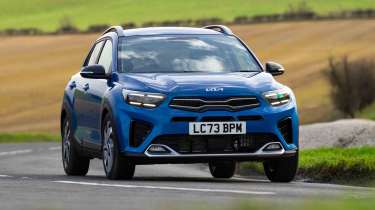
Model |
Power |
0-62mph |
Top speed |
| Kia Stonic 1.0 T-GDi 2 manual | 99bhp | 10.7seconds | 115mph |
| Kia Stonic 1.0 T-GDi 2 DCT | 99bhp | 11.7seconds | 109mph |
Kia engineers have re-tuned the Kia Rio’s (the car upon which the Stonic is based) rather average MacPherson strut front and torsion-beam rear axle suspension set-up to handle the Stonic’s higher centre of gravity. In doing so, they’ve also created a car that feels more agile, is relatively roll-free, and handles things in a composed and tidy fashion. The steering is light, if lacking in feel, and the gearchange is easy and slick.
While the Stonic has enough grip, it never quite feels settled on the move. The suspension fidgets around, and the damping over aggressive bumps is not as smooth as some rivals. The Kia isn’t as comfortable or as relaxing on the motorway as some of its competitors either. There’s not much roll, and you can carry a good amount of speed through corners, but the Stonic never feels fun in the way a Ford Puma does. Neither does it inspire as much confidence, as this unsettled edge undermines much of the car’s other, acceptable dynamic qualities.
Performance was never startling from any of the formerly available engines, but the 1.0-litre three-cylinder engine is an improvement on what went before.
The downsized turbo unit makes 99bhp and delivers its power without too much noise and fuss. It's a little rattly at idle, but pulls smoothly and revs well. Once you’re on the move, the Stonic is refined and manages to be reasonably quiet at a cruise.
The engine responds well to everyday driving demands, and the 0-62mph time of 10.7 seconds and top speed of 115mph for the manual version is not too shabby. The automatic version takes a little longer to 62mph, at 11.7 seconds, and the top speed is reduced to 109mph.
MPG, CO2 and Running Costs
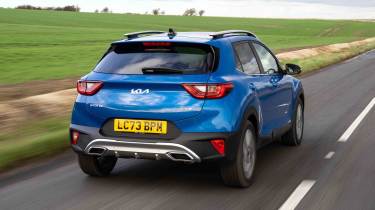
Model |
MPG |
CO2 |
Insurance group |
| Kia Stonic 1.0 T-GDi 2 manual | 51.4mpg | 125g/km | 9E |
| Kia Stonic 1.0 T-GDi 2 DCT | 51.4mpg | 125g/km | 8E |
Whichever model you choose, there isn’t a Kia Stonic that’s going to cost a lot to run – the 1.0-litre turbo petrol under the small SUV’s will achieve up to 51.4mpg on official figures.
For company car drivers, the Benefit-in-Kind (BiK) rates are similar for all versions of the Stonic, thanks to reasonably low CO2 emissions starting from 125g/km. All models attract the same standard rate VED road tax and avoid the luxury car tax because no version costs more than £40,000.
The relatively pedestrian performance of the Kia Stonic means it doesn’t get whacked with outrageous insurance premiums. Ratings range from groups 8 for a 2 trim automatic to 10 for the GT-Line S manual.
The old days of disastrous depreciation are behind Kia. Our expert data suggests the Stonic will retain between 45 to 48 per cent of its original value after three years and 36,000 miles of motoring. That’s on par with a number of small SUVs, but not as impressive as the Ford Puma, which is predicted to keep an average of 52 to 54 per cent over the same period.
To get an accurate valuation on a specific model check out our free car valuation tool...
Interior, design and technology
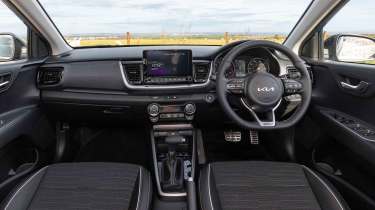
The Kia Stonic is unashamedly setting its sights on buyers who want a small SUV with a bit of style and panache, but it’s not as characterful as some in the sector, such as the Hyundai Bayon or Ford Puma. If you don’t want a car that’s too ostentatious, you might think that’s a good thing.
The Stonic isn’t frumpy or dowdy though, especially in brighter colours. The crossover shares its ‘Tiger nose’ grille design and swept-back headlamps with its Rio stablemate, but in keeping with its SUV pretensions, the bodywork is more muscular and beefy. Black plastic sill guards and wheelarch trims, along with standard-fit roof rails, all help create a slightly more adventurous look when contrasted with bright paint.
Inside, the Stonic benefits from a functional and attractive design, as well as impressive fit and finish for this class. However, although the fascia appears extremely well manufactured and impeccably screwed together, Kia has gone heavy with hard and brittle-looking black and grey plastics, and we’d like a bit more attention paid to lavishing the interior with more soft-touch materials. Sadly, you can no longer add colour-coded interior packs to the Stonic. These added your choice of grey, bronze, orange or green trim highlights, and definitely gave the cabin ambience a bit of a lift.
Sat-nav, stereo and infotainment
Kia’s eight-inch touchscreen infotainment system is one of the better systems on the market at this price, but can’t quite match the ease of use of the Google-based R-Link system used in the Renault Captur. Still, the menu layout used in the Stonic is relatively straightforward to work out and use on the move, and the graphics are decent.
When it comes to smartphone connectivity, Android Auto and Apple CarPlay are both standard fit and give buyers an alternative option for nav on the entry-level 2 trim; GT-Line trim or higher, get sat-nav as standard. On top of this, connected services with TomTom live traffic for the built-in nav, a reversing camera, Bluetooth and a six-speaker stereo are all included in the price.
Practicality, comfort and boot space

Dimensions | |
| Length | 4,140mm |
| Width | 1,760mm |
| Height | 1,505mm (1,520mm in roof rails) |
| Number of seats | 5 |
| Boot space | 352-1,155-litres |
We’ve already discussed the shortcomings in the Stonic’s ride quality, which will particularly affect drivers using urban and minor roads. Another area where the Stonic may fail to meet the desires of its potential owners is the seat height. Lots of buyers look to SUV-type vehicles for a more reassuring and commanding driving position, yet the seats in the Stonic are set relatively low compared to most of its rivals. That said, if you prefer a sportier driving position, this car could fit the bill.
There are lots of practical touches when it comes to cabin storage though. You get big door pockets up front, a pair of cup-holders and a seven-litre glovebox, as well as useful storage built into the central armrest and console. There are cup-holders for the kids’ water bottles in the back, a rear USB charging point and shopping hooks in the boot, too.
Naturally, the taller body style of the Kia Stonic compared with the (now discontinued) Kia Rio, and means headroom for rear seat passengers is improved. However, the wheelbase constraints mean there’s no more rear seat legroom than in the Rio hatch, which means it’s adequate but not luxurious: compared to some small crossover rivals, it feels more cramped – and the dark cabin doesn’t help.
You get 352 litres of boot space in the Stonic, which is a little more than the Rio hatchback, but significantly less than some of the Stonic’s larger rivals. For instance, the Peugeot 2008 has 410 litres, and you can have up to 455 litres in the Renault Captur with the rear seats pushed forward.
With the seats folded, you can get a maximum of 1,155 litres and a flat load floor, but again the rivals do better. At least the Stonic has a wide-opening tailgate so access is easy, but there’s a pronounced loading lip, although it's no worse than you'll find in a SEAT Arona.
Reliability and Safety
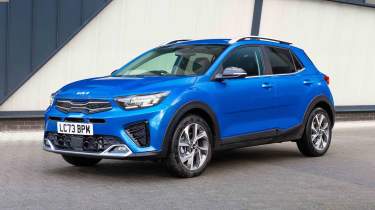
Independent crash tester Euro NCAP tested the Kia Stonic in 2017 and awarded it a three-star rating for the basic version without the safety pack, or a five-star score for cars with it. Due to the test having been updated and made more stringent since then, this rating has since expired. That doesn’t mean the Stonic wouldn’t still protect you well in a collision, but it is a shame that it hasn’t been retested like the SEAT Arona has, which has a valid five-star rating.
There are plenty of safety assistance features fitted as standard to help prevent you from getting into trouble in the first place, such as autonomous emergency braking (AEB), lane keep assistance, a driver attention warning, and high beam assistance. You will have to upgrade to the top-spec GT-Line S in order to get blind spot monitoring, which is a useful system to warn you of vehicles to the side of you when changing lanes on the motorway.
The Kia Stonic managed to finish 30th on our list of 50 of the best cars to own - based on owner feedback from our 2024 Driver Power satisfaction survey, while the Kia brand came third in the best manufacturers rankings, which is a terrific result.
The Kia seven-year warranty is unbeatable, providing 100,000 miles of cover on all the manufacturer’s new cars. It’s undoubtedly part of the Kia brand appeal, and has also helped boost second-hand values. Toyota offers up to 10 years/100,000 miles of coverage, although you do have to have the car serviced at a franchised dealer annually in order to extend it to the full 10-year period.
Servicing is needed every 12 months or 10,000 miles with the Stonic, and you can purchase a Kia Care Plan to fix the price of maintaining your car.
Key standard safety features |
Euro NCAP safety ratings |
|
|
Kia Stonic alternatives
Rivals for the Stonic kick off very close to home, because the Hyundai Bayon also shares its platform with a supermini (the Hyundai i20 in its case) and is available exclusively with petrol power, but comes in a more adventurous shape compared to the Kia.
Elsewhere, the Nissan Juke is the founder of the small crossover class, while other rivals for the Stonic include the Ford Puma, Renault Captur, Peugeot 2008, Citroen C3 Aircross, SEAT Arona and Toyota Yaris Cross. For a leftfield choice, there's the Suzuki Ignis high-riding supermini, or you could go for the Dacia Duster, which offers rugged simplicity and more space for a lower price.
Deals on the Kia Stonic and alternatives
Kia Stonic owner reviews
Here’s what owners in the 2024 Driver Power survey thought of the Kia Stonic.
| What they like | What they don't like |
| “I spent a long time choosing what car to buy. Every time I get in it and drive off I know that I made the right choice.” | “The dashboard reflects in the windscreen quite badly at night, so it creates an unnecessary distraction.” |
| “It’s excellent value. I could buy a family car from Kia for the cost of a smaller car from other manufacturers.” | “The fuel economy is really disappointing for what is not that big a car. It’s especially poor in urban driving.” |
| “The infotainment is easy to set up and has a high-quality sound. Phone connectivity can be a bit erratic, though.” | “The carpet is cheap and everything sticks to it like Velcro, so cleaning the interior is time consuming.” |
| “The nav is easy to use, with clear maps and instructions given in good time. But it isn’t easy to update.” | “There isn’t enough rear-seat legroom, there’s too much road noise, and the ride is too firm for UK roads.” |
| “The brakes are really good; there’s lots of stopping power and a nice light pedal. The steering is very responsive and the ride quality is excellent, given the terrible state of our roads.” | “There aren’t nearly enough cubbies and the boot is too small. There isn’t legroom for four adults on a long trip.” |
| “All-round vision is excellent; the cameras and sensors help and they all work really well. The quality of the materials is very high – I’d say they’re on a par with those in far more costly cars.” | |
| “There’s decent boot space. Four shopping bags fit in easily, or our dog crate, if the back seats are folded down, turning the car into a two-seater. With the back seats used, there’s enough room for children, or a couple of adults if they’re not too tall.” | |
| “The three-year service plan is good value and I can easily get 50mpg on my commute, or even 60mpg on a longer motorway run.” | |
| “It looks very sporty and more expensive than it is. It’s exciting to drive and has a lot of useful tech on board.” | |
| “It’s far more comfortable than my previous MINI. I really wish that I’d changed to a Kia much sooner.” |

